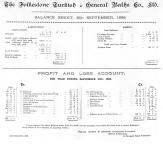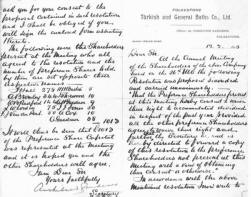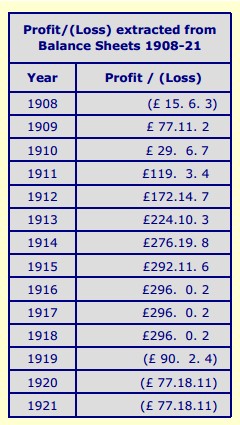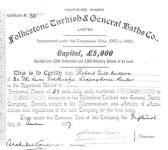This is a single frame, printer-friendly page taken from Malcolm Shifrin's website
Victorian Turkish Baths: their origin, development, and gradual decline
Visit the original page to see it in its context and with any included images or notes
Folkestone Turkish & General Baths Company Limited
Company baths: FOLKESTONE: 1 & 3 Ingles Road
As handwriting is often unclear,
all name transcriptions below are indicative only.
When accuracy is important, the original documents should be consulted.
PRO (Public Record Office) documents are at The National Archives, Kew.
Quite soon after opening their Turkish baths, the company became increasingly worried about the difficulty of making them profitable. The company had lost £150.1.5. in their first year (to September 1897) and £95.10.9 in their second. Clearly the first set of Directors, all now replaced, had overestimated the facilities required to meet their bathers' needs.

Statement of accounts, 1898
During 1898 the Directors converted part of the men's hot and cold baths (still leaving two) into a barber's shop which was now let at 12/6 per week. And, at a cost of £245.3.2, they had converted part of the women's baths into living rooms for the Head Shampooer and his wife, which made a saving of 11/- per week. In their Report submitted at the 3rd Annual Meeting of the company, the Directors wrote, plaintively,
If the Shareholders would only patronise the Baths themselves, and induce their friends to do the same, there might be some hope of the undertaking paying; unless some effort is made to increase the takings to more than £400 per annum, the concern cannot pay its way.
After the first year the Preference shareholders waived their dividend. After the second year they were asked to do so again and the company borrowed £500 from the bank.

Letter from the Company Secretary
to the preference shareholders asking
them to waive their dividend
When, towards the end of the following financial year, things had not improved, the Board instructed Archibald Gardener, the Company Secretary, to approach the local Council with a view to their taking the baths over. So on 29 August 1899, Gardener wrote to the Corporation in time for the letter to be read to Members at their meeting on 6 September.
In the letter he explained that the Turkish baths were built only four years earlier, but that 'owing to the lack of adequate support' the company would be compelled to close them at the end of September, which coincided with the end of their current financial year. He wrote:
…Before closing the doors, my directors desire me to offer the institution as a going concern to the Corporation, in the hope that they will keep the same open in the interests of the town. Since the buildings were acquired the company has spent £500 in additions and improvements, the subscribed capital of the company is £4,200, in addition to which there is a mortgage debt of £1,200…
He even suggested that if the Corporation agreed to negotiate a sale, the company would be willing to pay half the fee of a baths expert for the purpose of arriving at a fair valuation of the premises, which had about 94 years unexpired lease, at a ground rent of £15.
The Council decided to refer the matter to their General Purposes Committee which, after discussion, asked the Town Clerk to write to other towns with Turkish Baths in order to help them with their decision.
On 16 November, the Town Clerk reported that he had received replies from Bolton, Birmingham, Cardiff, Dewsbury, Gloucester, Leeds, Leamington Spa, Sheffield, Southampton, Stafford and Walsall. However, after these had been discussed, the committee resolved that they 'cannot see their way to entertain the proposal...'

The company continued running the baths themselves for a few more years but some time around 1902 they decided to lease them to John James Lewis, who had been their Baths Manager for the previous four years.
In 1909 the company made a small profit of just under £80. But although there was a loss the following year, things began to improve until they were making profits of over £290 in each of the three years 1916-18.
However, in 1919, just after the end of World War I, attendance plummeted and there was a loss in each of the three following years. The company decided that the baths must close.
TNA: PRO: BT31 15529/45564 All unfootnoted information is taken from this file.
1895 Memorandum of Association: 9 October
Capital: £5,000 divided into 5,000 shares of £1
Secretary: Archibald Gardener
Objects include: to acquire land and premises at Ingles Road
Registered Office: 8a Cheriton Gardens (Office of Secretary)
Agreement: between John Lacey Davies, and the Company, to purchase his land for building a Turkish Baths, for a consideration of £5,000 comprising £3,000 cash and £2,000 by allotment of 1,000 Preference Shares numbered from 1 to 1,001.

Preference Share certificate
Davies to be Managing Director of the Company without fee for one year.
Completed: 25 November.
1896 Directors:
Booker, John Harrocks (Retired merchant)
Davies, John Lacey (Retired civil engineer)
Le Grice, Frederick Swaine (Colonel)
Tyson, William Joseph, MP
Architect: Andrew Bromley
Secretary: Archibald Gardener (7 March)
1899 Directors:
Bromley, Andrew (Architect)
Hall, Frederic (Solicitor)
Ralph, Frederich (Restaurant & hotel proprietor)
Wampach, Charles Constant (Hotel proprietor)
Secretary: Archibald Gardener (18 January)
1901 Directors:
Bromley, Andrew (Architect)
Hall, Frederic (Solicitor)
Ralph, Frederich (Restaurant & hotel proprietor)
Wampach, Charles Constant (Hotel proprietor)
Average number of shareholders: 45
1907 Directors:
Bromley, Andrew
Hall, Frederic
Ralph, Frederich
Wampach, Charles Constant
1915 Directors:
Bromley, Andrew (Architect)
Hall, Frederic (Solicitor)
Ralph, Frederich (Restaurant & hotel proprietor)
Wampach, Charles Constant (Hotel proprietor)
1921 Directors:
Hall, Frederic (Solicitor)
Ralph, Frederich (Restaurant & hotel proprietor)
Wampach, Charles Constant (Hotel proprietor)
1923 Registered Office: Bowerie Chambers (1 February)
Extraordinary Meeting for winding up company
Liquidator: Frederic Hall
1924 Wound up: 29 April
This page last updated
04 December 2021
The original page includes one or more footnotes,
and thumbnail images which can be enlarged.
Any enlarged image, listed and linked below, can also be printed.
Statement of accounts, 1898
Letter to Preference Shareholders
Summary of balance sheets
Preference Share certificate

Victorian Turkish Baths: their origin, development, and gradual decline



Comments and queries are most welcome and can be sent to:
malcolm@victorianturkishbath.org
The right of Malcolm Shifrin to be identified as the author of this work
has been asserted by him
in accordance with the Copyright, Designs and Patents Act 1988
© Malcolm Shifrin, 1991-2023